Inside look: IKEA LED strikes back
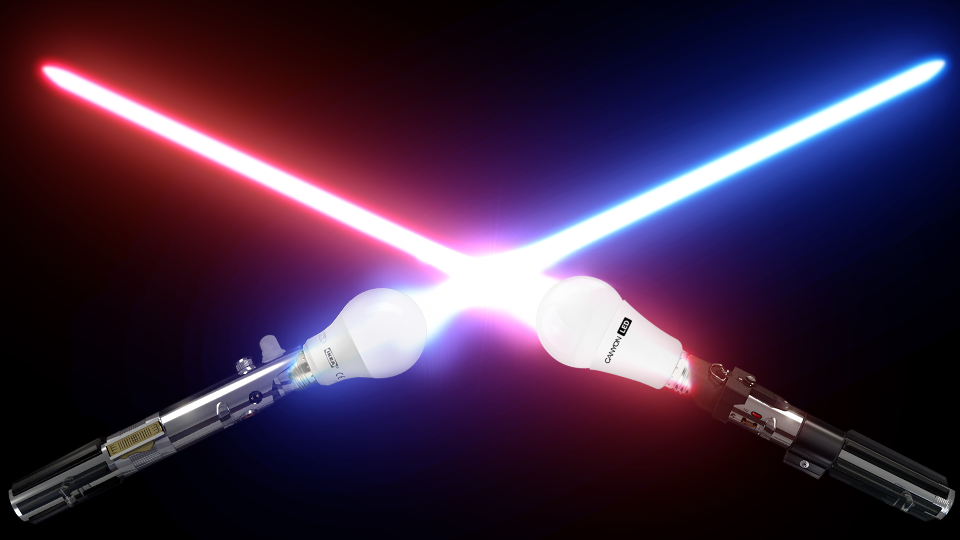
Hello again, my big and small fans of thorough testing and analysis of LED-lamps!
Today, on the operating table under the pliers and a screwdriver , IKEA actively praised lamps came across , and so that they would not be bored and lonely under the bluish lighting of the operating room, we will add Canyon lamps of the same price category to the piggy bank . Actually, let's delve into them in more detail.
Caution, under the cut a lot of pictures!
About Ikei bulbs already written and said enough. At the moment, they have become the holy grail of LED lighting with a CRI of about 90, a reasonable price (about 350 rubles at the beginning of January 2016) and a small ripple coefficient ( 1 , 2) About Canyon bulbs, it is worth noting that they are similar to IKEA bulbs at a price (slightly cheaper, about 20-30 rubles approximately), but they are not so common in retail, so we only compare bulbs in the most common cases - E14 and E27.
The testing methodology remained the same .
For those in a hurry: two summary tables with lighting characteristics (CRI, CCT, and so on) and with the data obtained during the analysis of the lamps are presented at the very end of the article along with brief conclusions.
Ledare E27 400 lm
So, let's start, sir. The first bulb is the non-dimmable Ledare E27 400 lm ( LED1338G7 ).
NB: The catalog numbers of the IKEA lamps presented in the review may not coincide with the lamps sold in the Russian Federation. Therefore, when choosing, pay attention to the first two and last two digits / letters - G7, G9, C6 and so on.
In general, the bulb is not bad, it does not make much noise - only a few percent, while the pulsations of the light flux occur at 100 Hz, which, potentially, should not harm the eyes and affect the quality of lighting. As for the temperature, there were no questions either - within the limits of GOST standards, but CRI let us down - the measured value is "slightly" lower than the declared 90.
Since the lamp was in use for some time, there are certain fears that an underestimated CRI is associated precisely with the burnout / degradation of either a polymer or a phosphor that converts blue to green and red. By the way, it would be interesting to check: the degradation of the lighting characteristics of the lamps after, for example, an hour, 100, 1,000 and 10,000 hours of real work.

During the analysis, it turned out that only 5 SMD assemblies with 2 LEDs in each were installed in the light bulb, which is slightly surprising considering the declared luminous flux of 400 lumens and the previous results of lamp analysis ( parts 2 and 3 ). The diffuser, as expected, is plastic and is firmly fixed to the lamp itself.

But the driver cannot be removed just like that, it is reliably, with a 146% guarantee, soldered to an aluminum substrate with LEDs and will not fall off the lamp under any circumstances - only together with the aluminum substrate itself. Despite the fact that the heat sink is organized only along a thin ring, the LED assemblies located also on the periphery should not noticeably overheat.
The driver circuitry resembles a Gauss 12W light bulb with minor changes, somehow a hefty capacitor in front of the LED board (double-checked - as much as 270 uF!), But even it does not drown out all the ripples. Unfortunately, reference design could not be found, but for those who like to dig around, the control microcircuit is marked as follows: 8022VT2GN // CG180R.1N // 1514A1.

LED chips measuring 273 by 173 microns are made of a completely standard sapphire substrate with a star-shaped texture. This type of texture is perhaps the most common today among various manufacturers .
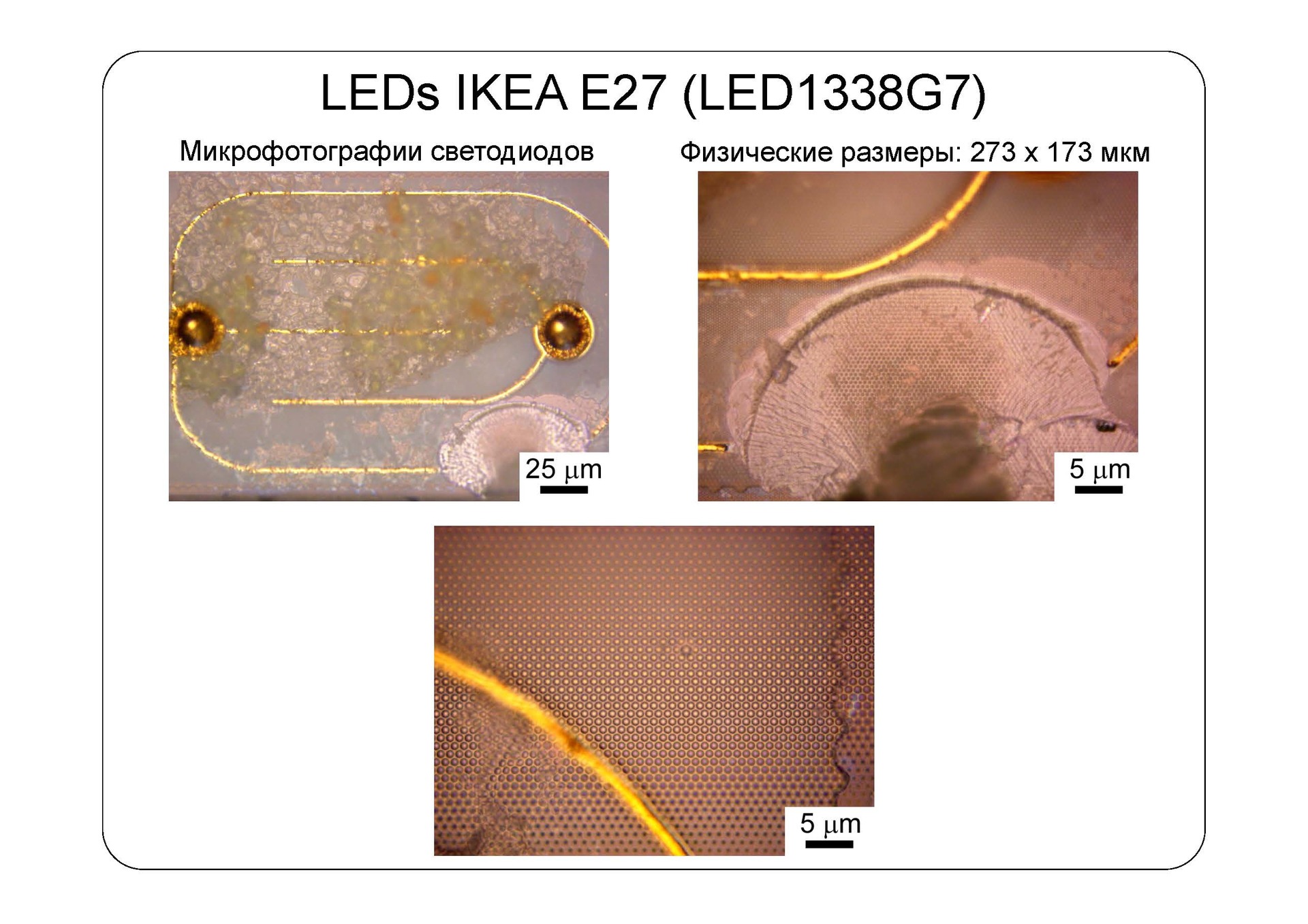
Ledare E27 600 lm
The second experimental rabbit is the already dimmable Ledare E27 600 lm bulb ( LED1466G9 ). Unlike the younger brother, everything is in order with her: the declared temperature and CRI are fully consistent with the measured values. The ripple coefficient is also not large - a little more than 2% at a frequency of 100 Hz.

Analysis of this lamp showed that the light-scattering bulb is not firmly fixed to the main body of the lamp: for about a tenth of the circumference there is no sealant at all with all the problems that

The driver, like its predecessor, is compact and lightweight, although it is crammed with a large number of components. Marking the control chip LYT4322E, for which on the Internet you can dig up a lot of examples of applications for dimmable lamps ( something like that ). It is worth noting that this microcircuit is installed vertically, and not soldered to the board (marked with a red arrow in the figure below) - an amazing saving of space.
On an aluminum substrate with SMD assembly and LED in a peculiar way the temperature of this lamp is indicated (numbers 27, 30, 40, etc.).
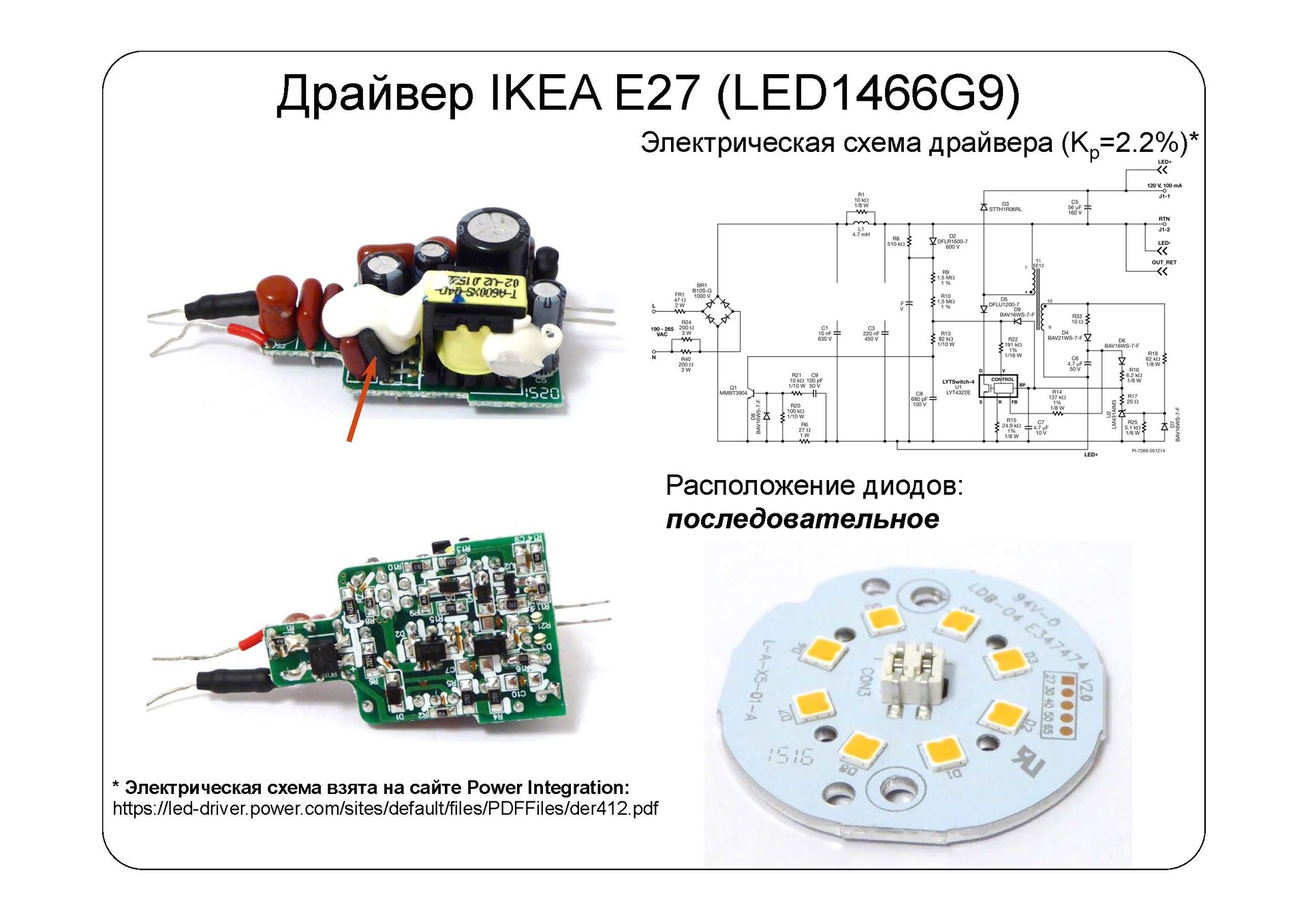
In total, LED assemblies 8 pieces of 2 crystals per assembly. However, they are located closer to the center of the lamp, and, accordingly, can overheat, due to inefficient heat dissipation. The size of the LEDs themselves also differs from the size of the crystals of the younger brother - 311 by 163 against 273 by 173 microns.

Ledare E14 400 lm
The last representative from Sweden today is a newly dimmable bulb, but in the E14 base ( LED1407C6 ). In terms of spectral characteristics, this bulb is also a worthy representative of the family: a small ripple factor of about 2.4% at a frequency of 100 Hz and excellent CRI and temperature.
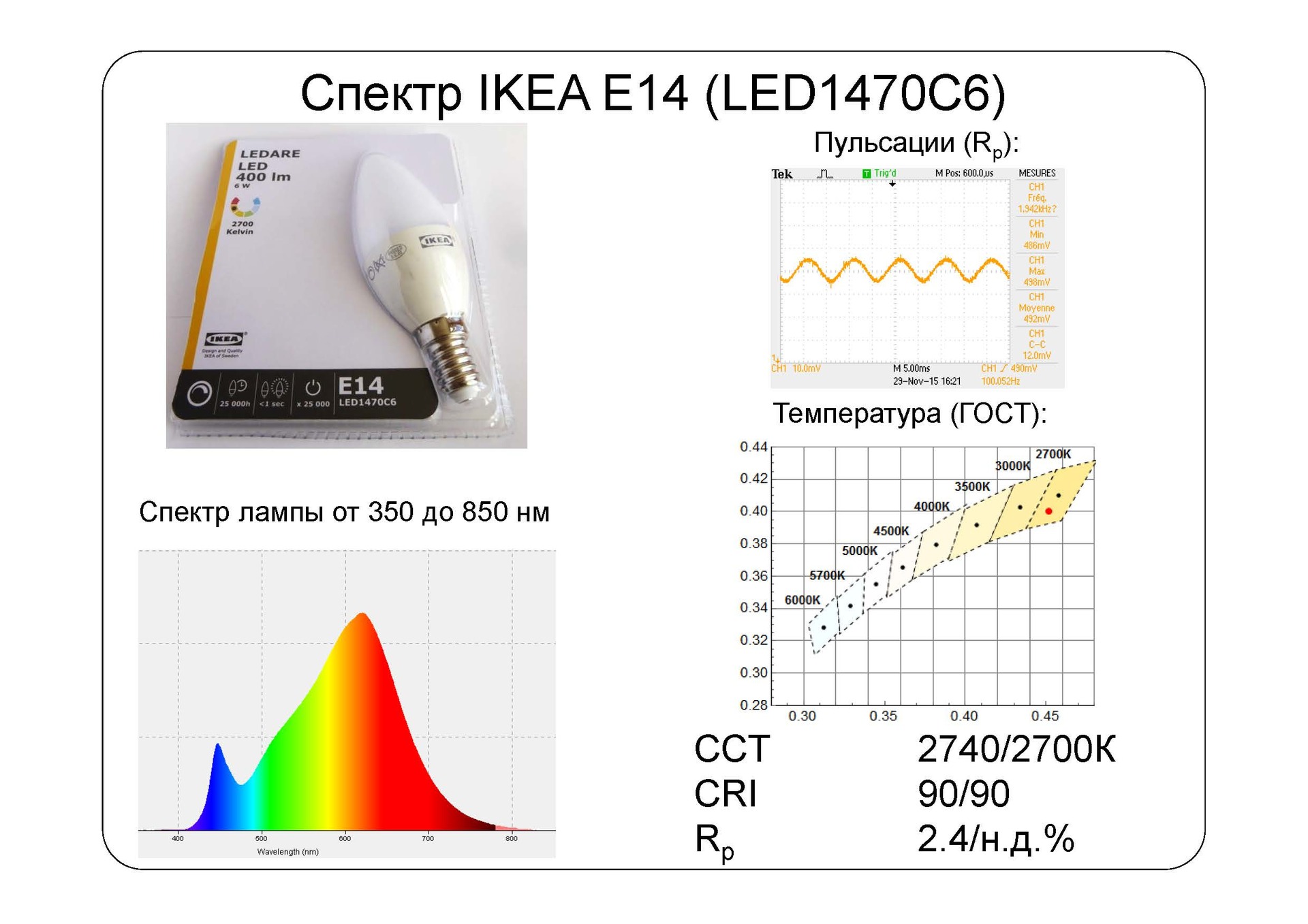
However, during the analysis, some interesting features of this lamp were found out. Firstly, the diffuser is fixed on latches and, therefore, can not guarantee any protection, both from moisture and from children, who can relatively easily disassemble it. Secondly, the diode assemblies themselves are located in the center, while the heat sink is carried out only in a circle of the case - that is, completely analogous to the lamp considered above.

The driver is densely packed with containers, there is literally no empty, unallocated space in it. The control chip appears to be produced by Marvell (chip marking is mrvl // 187A4R1 // 517AMTG). ) Marvell has a control chip 88EM8187 , and it is designed just for dimmable lamps.

The connection of all 10 (2x5) LEDs is serial, and the size of each crystal is 328 by 177 micrometers.
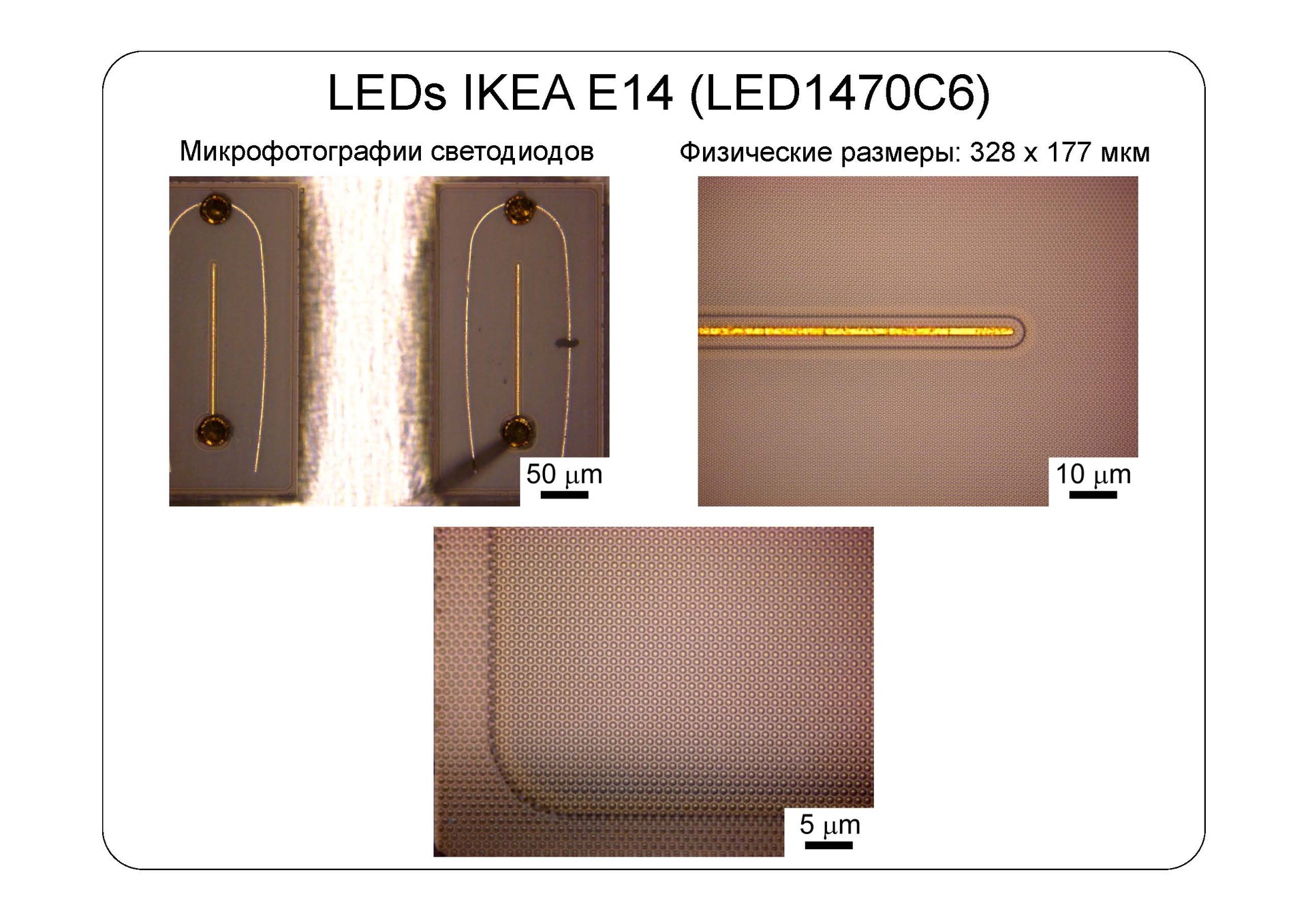
Next, we look at two non-dimmable Canyon “production” lamps in the E27 and E14 sockets.
Canyon E27 806 lm
Both Canyon bulbs have one serious drawback - glass rather than polycarbonate (plastic) diffuser, so be careful when handling these bulbs.
The lamp in the E27 form factor was not as good as its counterpart E14. High temperature - 2950K instead of 2700K, a relatively high level of ripple - 3.7%. But CRI is fully consistent with the claimed packaging - 80 units.
Why is the color temperature different from the declared one: the method on the fingers and without an engineering education
Why did the temperature creep up by more than 200 degrees and crawl beyond the limits established by GOST? This is easy to understand if you look at the distribution of the fill, which should "lower" the temperature, on the surface of the substrate with LEDs: closer to the contact group, such a fill is small, whereas on the other side it is covered with a very thick layer (almost a double difference in thickness!) . Apparently, the entire board was tilted in production: a few degrees would be enough for the liquid polymer to flow to one side without having time to harden. As a result, it resulted - in the literal sense of the word - in the discrepancy of the declared color temperature. At the very end, we will return to this point with the corresponding graphs.

The rest of the lamp is well designed: a robust housing with a massive aluminum insert for heat dissipation and efficient dissipation, a compact driver and an original solution for LED substrates.
Quickly found reference design of this circuit in the form of a test report from Minwa Electronics - is in the public domain here . The testing is fresh, conducted in 2014, it confirmed the full compliance of the lamp with EU safety standards (with the exception of the bulb, probably).

The individual LEDs are connected in series in a circle and filled with a phosphor that converts blue light into green, yellow and red. It would be interesting to compare this arrangement with a conventional one (LED in SMD-housings) in terms of the angle of illumination and the uniform distribution of the light flux. In my opinion, such a “ring” package has its undeniable advantages.
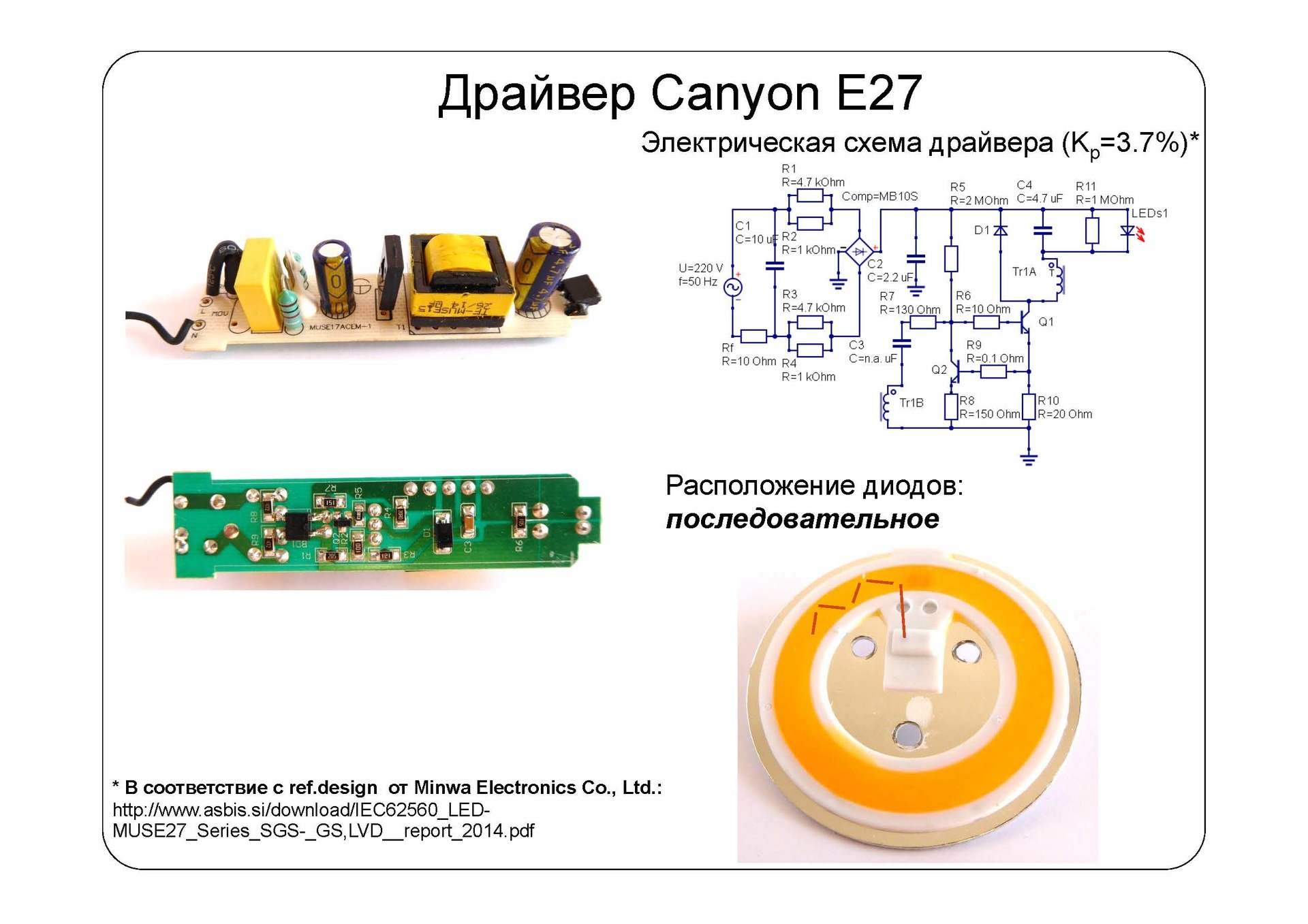
The crystals have a rare square shape (for some reason, most LEDs are still rectangles) with a side of 163 microns. In total, there are 54 such tiny LEDs in the circle.
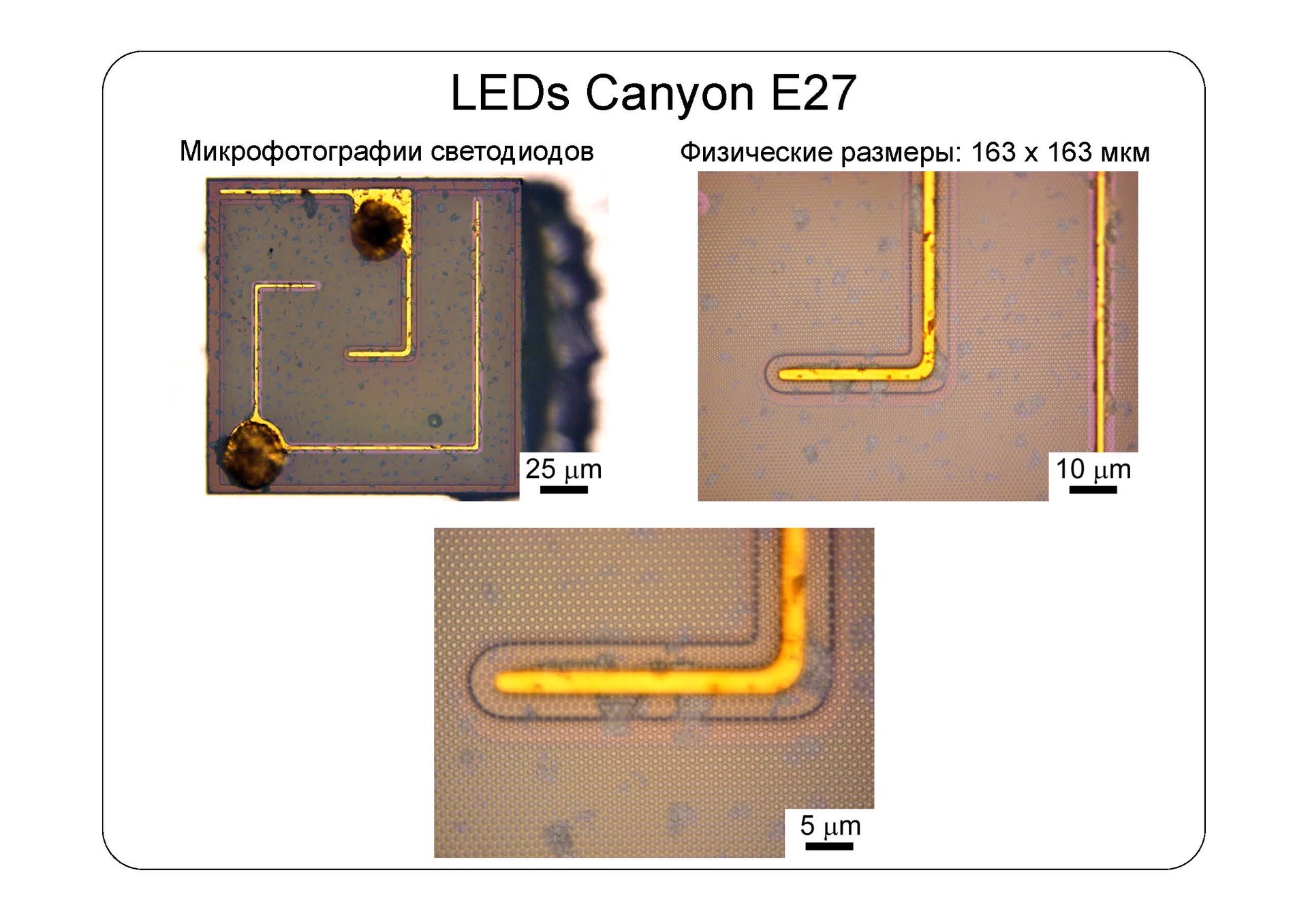
Canyon E14 250 lm
The Canyon E14 bulb is almost like a twin brother similar to its eldest progenitor in terms of device, but surpasses it in terms of lighting performance. So, this lamp falls well in the color temperature range, has excellent CRI and the lowest ripple coefficient among all tested lamps.

Of course, a lamp with such an intricate shape should serve more for decoration than any kind of functionality and reliability. In principle, glass can withstand a drop on the carpet from a height of 1-1.5 meters, but no more. The Canyon E14 also uses an interesting diffuser, directing the light flux to the sides, and not strictly in the center.
The driver with a transformer and MOSFET is compact and freely interferes in the “basement” room of this light bulb.

In this case, the driver, with the exception of a pair of resistances and capacitors, is an exact copy of the driver from the E27 bulb. Again, the test report of these lamps is in the public domain .

Standard LED sticks measuring 250 by 87 microns are packed in a circle in an amount of 18 pieces. At the same time, as in the case with other lamps, the LEDs are made on a sapphire substrate with an asterisk texture.
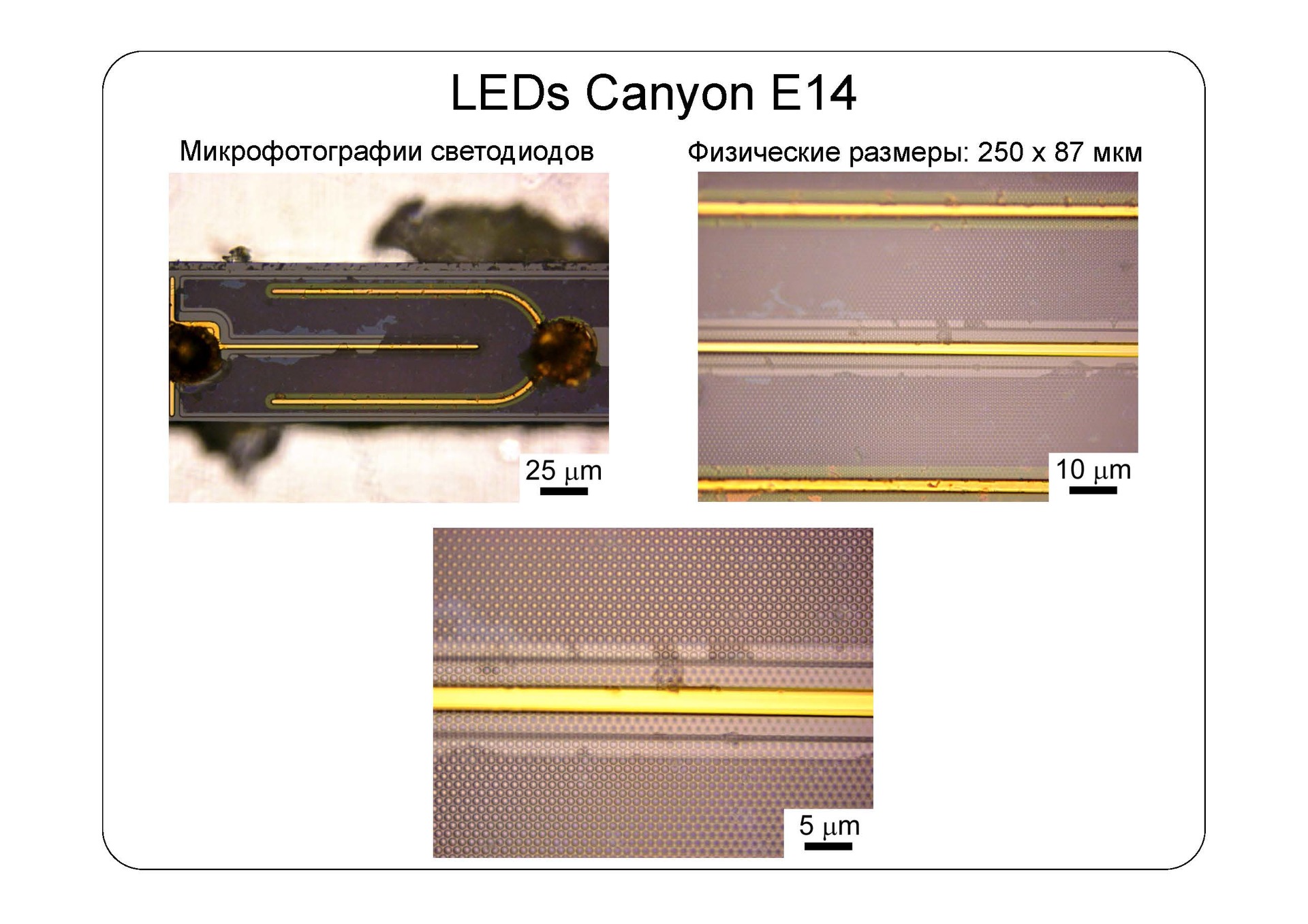
conclusions
Well, the bulbs are tested, let's try to summarize some results together.

- The obtained data of lighting characteristics are summarized in the tables below. All bulbs showed excellent results with the exception of IKEA Ledare E27 (LED1338G7) and Canyon E27 (CRI and temperature, respectively). There are suspicions that both of the lamps presented are victims of manufacturing defects or exploitation, as is the case with IKEA Ledare E27 (LED1338G7). Having glanced inside Canyon E27, the defect of filling of a phosphor is visible to the naked eye.
- Comparison of the spectra of light bulbs brought a lot of surprises and entertaining observations:
a. The Canyon E27 bulb with a rather strong blue component (about 450 nm) is clearly striking from the total mass . As noted above, this bulb has a real color temperature of 2950K instead of the declared 2700K.
b. In different IKEA lamps of the same color temperature, a different phosphor is used - this is a twist! Perhaps the “wrong” phosphor composition spoils the color rendering and underestimates the CRI for the Ledare E27 lamp (LED1338G7) ?!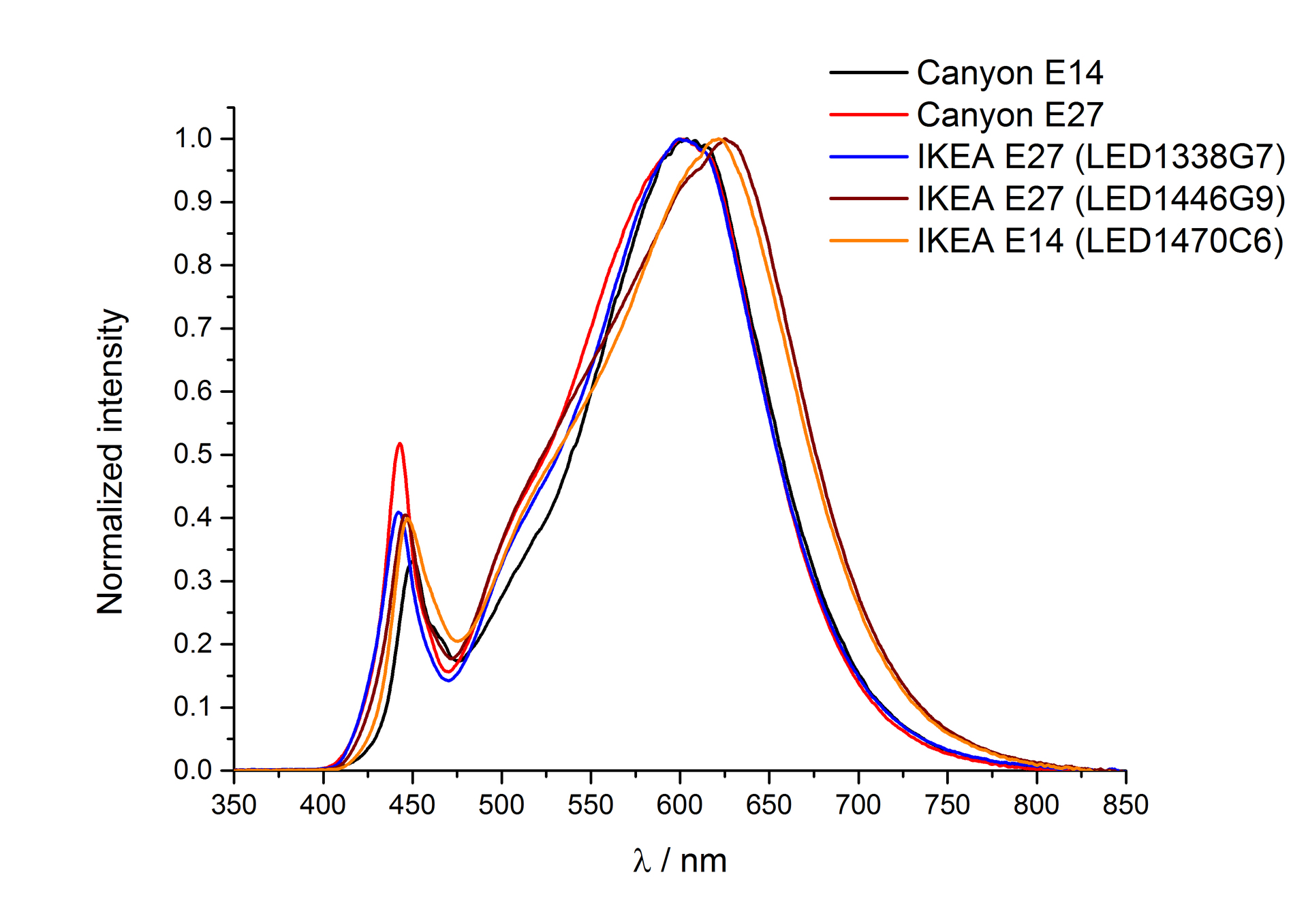
- From the point of view of the engineering component, the tested lamps are made at the proper level. This applies to drivers (in all lamps, a driver is installed on the basis of a flyback converter, somewhere it is with the ability to adjust lighting, somewhere not), and the LED assemblies themselves. Among other things, the following can be noted:
a. IKEA lamps showed an excellent luminous flux of 38-40 lumens / crystal - this is really an achievement, while the heat dissipation still remains at the level of 10-13 W / mm 2 , which is comparable to the previously tested lamps from Gauss, eg. The relatively large heat dissipation and irrational design of the heat sink (heat sink on the periphery, and the assembly in the center), in my opinion, will be one of the factors contributing to the rapid degradation of the bulbs (how can we not recall the planned obsolescence ). In other words, the lamp will not turn into a boiler, as happened with the Pulsar lamp in the last test , and will please you with long and bright work, but for how long ?!
b. For some reason, Canyon decided to put a glass diffuser in the light bulbs instead of polycarbonate. For the E14 lamp, this can somehow be explained in terms of design, but for the E27 it is better to replace it with something more reliable.
Well, the long-awaited analysis and testing of filament bulbs is next in turn: let's compare the store, and therefore certified, with the one ordered on eBay. We will see what kind of fruit this is!
PS: Recently in Kommersant an absolutely stunning article was published on the topic of how to ... (oh yes, you can’t use foul language) to lose control over OptoGaN and everything that happens around you, and so there is nothing for you - I advise you to read it .
PPS: Believe it or not, Zelenograd Micron sells control chips and even entire drivers for LED bulbs at all - that’s what it would be interesting to test!
By the way, do not forget to subscribe , it’s not difficult for you, but we are pleased!
UPD:As the Raziel user on science.d3.ru correctly noted , the chokes are almost indistinguishable from resistors.
A full list of published articles “Inside View” on Habré and GT:
Opening the Nvidia 8600M GT chip , a more detailed article is given here: Modern chips - inside view Inside
view: CD and HDD
Inside view: LED bulbs
Inside view: LED industry in Russia
Inside view : Flash memory and RAM
Inside view: the world around us
Inside view: LCD and E-Ink displays
Inside view: digital camera arrays
Inside view: Plastic Logic
Inside view: RFID and other marks
Inside view: graduate school in EPFL. Part 1
Inside Look: Graduate School at EPFL. Part 2
Inside view: the world around us - 2
Inside view: the world around us - 3
Inside view: the world around us - 4
Inside view: 13 LED lamps and a bottle of rum. Part 1
Inside view: 13 LED lamps and a bottle of rum. Part 2
Inside view: 13 LED lamps and a bottle of rum. Part 3
Inside Look: IKEA LED Strikes Back
Inside Look: Are Filament Lamps So Good?
and 3DNews:
Microview: a comparison of displays of modern smartphones
